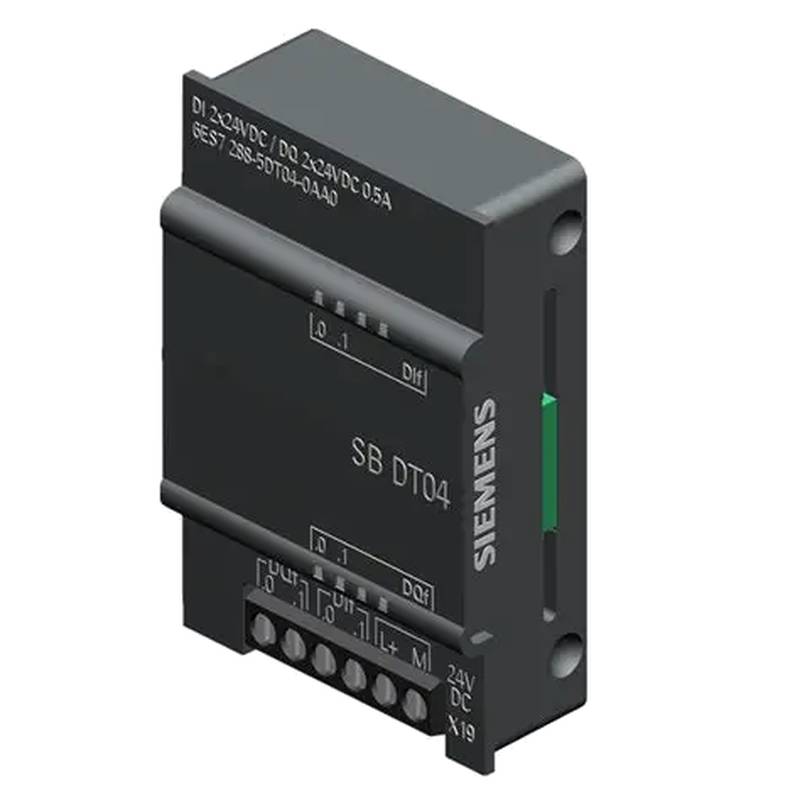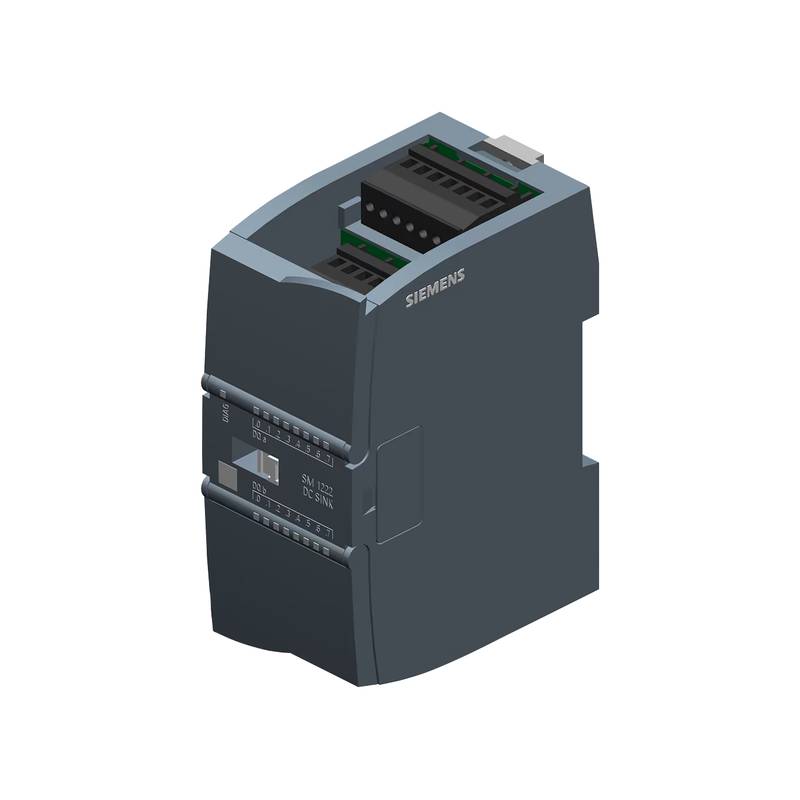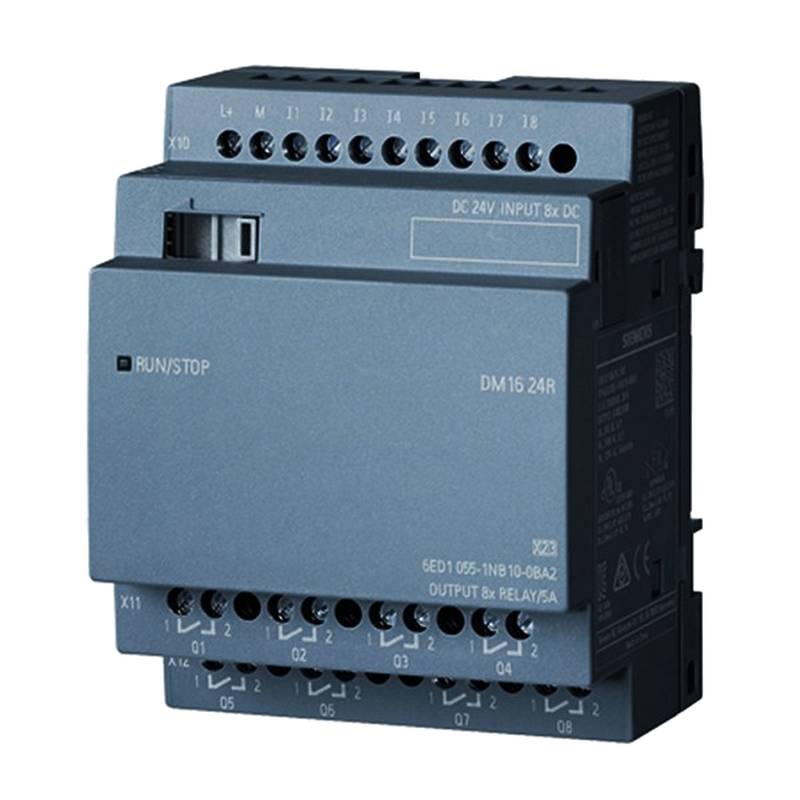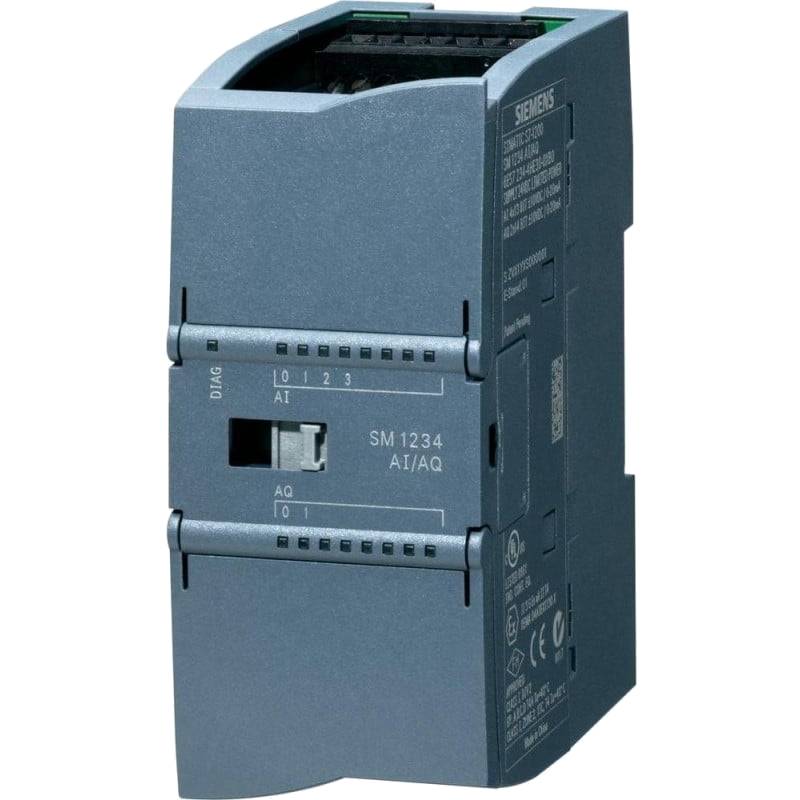
The Siemens 6ES7288-5DT04-0AA0 200 SMART 4-Channel RTD Input Module stands as a robust solution for precise temperature measurement in demanding industrial environments. This module offers four independent resistance temperature detector (RTD) input channels, ensuring accurate data acquisition for process control and monitoring. Its key advantages lie in its high accuracy, flexibility with various RTD types, and seamless integration within the Siemens SIMATIC S7-200 SMART automation system. Technically, it boasts a high resolution for detailed temperature readings and a wide operating temperature range, making it suitable for diverse applications.
Product Specifications
| Feature | Specification |
| :---------------------- | :-------------------------------------------------- |
| Module Type | 4-Channel RTD Input Module |
| Product Number | 6ES7288-5DT04-0AA0 |
| Compatible PLC Series | SIMATIC S7-200 SMART |
| Number of Channels | 4 |
| Input Type | Resistance Temperature Detector (RTD) |
| Supported RTD Types | Pt100, Pt1000, Ni100, Ni1000 (configurable) |
| Measurement Resolution | High (e.g., 16-bit equivalent) |
| Accuracy | High precision for industrial applications |
| Isolation | Channel-to-channel and channel-to-backplane |
| Supply Voltage | Via PLC backplane |
| Operating Temperature | -20 °C to +60 °C (typical range) |
| Dimensions (W x H x D) | Compact module size for DIN rail mounting |
| Protection Class | IP20 |
Core Features & Market Positioning
The Siemens 6ES7288-5DT04-0AA0 distinguishes itself through its dedicated design for the SIMATIC S7-200 SMART platform, offering a plug-and-play experience for users already invested in this ecosystem. Its multi-RTD support, encompassing popular types like Pt100 and Ni100, provides significant flexibility, reducing the need for specialized hardware for different temperature sensing requirements. The module's high accuracy and resolution are critical for processes where even minor temperature fluctuations impact product quality or operational efficiency. In the competitive landscape of industrial automation, this module is positioned as a reliable, cost-effective, and straightforward solution for essential temperature monitoring tasks, particularly appealing to small to medium-sized enterprises seeking dependable Siemens technology.
Key Application Scenarios
The 4-Channel RTD Input Module, Siemens 6ES7288-5DT04-0AA0, finds extensive use in numerous industrial sectors requiring precise temperature monitoring. In the chemical and petrochemical industry, it is vital for controlling reaction temperatures, ensuring process safety, and maintaining product consistency. Within the food and beverage sector, it plays a crucial role in pasteurization, sterilization, and storage temperature control, directly impacting product safety and shelf life. For HVAC and building automation, the module enables efficient energy management by precisely monitoring ambient and process temperatures. Furthermore, in machinery and equipment manufacturing, it facilitates the monitoring of critical component temperatures to prevent overheating and ensure operational longevity. Its versatility allows it to be integrated into various automation tasks, from simple data logging to complex feedback control loops.
Practical System Integration Guidance
Integrating the Siemens 6ES7288-5DT04-0AA0 module into an S7-200 SMART system is designed for efficiency. Installation involves snapping the module onto a standard DIN rail adjacent to the CPU or other I/O modules. Wiring the RTD sensors requires careful attention to polarity and the correct connection of the 2-wire, 3-wire, or 4-wire RTD configurations to the designated terminals on the module. Ensuring proper shielding and grounding of sensor cables is paramount to minimize electrical noise and maintain measurement accuracy. Configuration within the STEP 7-Micro/WIN software involves selecting the appropriate RTD type (Pt100, Ni100, etc.) and channel mapping for each of the four inputs. Diagnostic LEDs on the module provide immediate visual feedback on operational status and fault conditions, aiding in troubleshooting during commissioning.
Operation and Risk Mitigation
Effective operation of the Siemens 6ES7288-5DT04-0AA0 module hinges on adhering to specified environmental conditions and proper wiring practices. Operating the module outside its designated temperature or humidity range can lead to inaccurate readings or premature failure. Shielding of input lines from electromagnetic interference (EMI) is critical; unshielded or improperly grounded cables can introduce noise, degrading measurement precision and potentially causing process deviations. Users should regularly inspect connections for corrosion or damage, especially in harsh environments. Faulty RTD sensors or wiring breaks will typically be indicated by diagnostic LEDs on the module and specific error codes within the PLC program, allowing for swift identification and resolution. Implementing redundant temperature monitoring for critical processes can further mitigate risks associated with single-point sensor or module failures.
Scalability & Long-Term Value
The Siemens 6ES7288-5DT04-0AA0 offers a solid foundation for scalable automation solutions within the S7-200 SMART family. Its modular design allows for the addition of more I/O modules, including additional temperature acquisition units or other types of digital and analog I/O, as process requirements expand. This inherent expandability ensures that the automation system can grow with the business without requiring a complete overhaul of the existing infrastructure. Compatibility with the broader Siemens industrial automation portfolio ensures that this module can be integrated into larger, more complex systems or connected to SCADA and IIoT platforms for advanced data analytics and remote monitoring, thereby enhancing long-term operational efficiency and providing a valuable return on investment.
Frequently Asked Questions (FAQs)
1. What RTD types are supported by the Siemens 6ES7288-5DT04-0AA0 module?
This module supports common RTD types such as Pt100, Pt1000, Ni100, and Ni1000 sensors. These can be configured individually for each of the four input channels.
The flexibility in RTD type selection allows users to adapt the module to existing sensor installations or choose the most appropriate sensor for their specific application's accuracy and temperature range requirements. This reduces the need for specialized hardware converters and simplifies system design.
Configuration of the supported RTD type is performed within the STEP 7-Micro/WIN programming software, where you assign the correct sensor characteristic to each input channel, ensuring accurate signal interpretation by the PLC.
2. How do I wire a 4-wire Pt100 sensor to the 6ES7288-5DT04-0AA0 module?
For a 4-wire Pt100 connection, two terminals are used for the excitation current, and the other two are used to measure the voltage drop across the RTD. This configuration inherently compensates for lead wire resistance.
Connect the two terminals that supply the current to the designated excitation terminals on the module and the two terminals used for voltage measurement to the RTD sensing terminals. Refer to the module's manual for the exact terminal assignments.
Proper cable shielding and grounding are essential for 4-wire connections to prevent noise from affecting the voltage measurement, thereby maximizing the accuracy of the temperature reading.
3. What is the accuracy of the Siemens 6ES7288-5DT04-0AA0?
The module provides high-precision temperature measurements suitable for demanding industrial control applications. The exact accuracy specifications are detailed in the official Siemens technical documentation.
Factors influencing overall system accuracy include the quality of the RTD sensor, the integrity of the wiring, and the correct configuration of the module within the PLC software. Careful installation minimizes potential error sources.
The module typically offers a resolution that allows for detecting very small temperature changes, which is crucial for processes requiring tight temperature control and monitoring.
4. Can I use this module with PLCs other than the SIMATIC S7-200 SMART?
No, the Siemens 6ES7288-5DT04-0AA0 is specifically designed and engineered for seamless integration with the SIMATIC S7-200 SMART PLC series. It relies on the specific backplane and communication protocols of this platform.
Using the module with incompatible PLC systems would result in a failure to communicate, incorrect data acquisition, and potential hardware damage. Always ensure compatibility before attempting integration.
For users of other Siemens PLC families (e.g., S7-1200, S7-1500) or different automation vendors, alternative RTD input modules specifically designed for those platforms would be required.
5. What does the diagnostic LED on the module indicate?
The diagnostic LEDs on the 6ES7288-5DT04-0AA0 module provide real-time status information about its operational health and any detected faults. A steady green light usually signifies normal operation.
Flashing or red LEDs typically indicate a fault condition, such as an open circuit in an RTD sensor, a short circuit, a configuration error, or a module hardware issue. The specific meaning of each LED pattern is detailed in the product's manual.
Monitoring these LEDs is crucial for quick troubleshooting and identifying potential problems with the temperature measurement system before they impact the process.
6. How does lead wire resistance affect RTD measurements, and how does this module handle it?
In 2-wire RTD configurations, the resistance of the extension wires is added to the RTD's resistance, introducing an error in the temperature reading. This error increases with longer wire runs.
The 6ES7288-5DT04-0AA0 module supports 3-wire and 4-wire RTD connections, which are designed to compensate for lead wire resistance. The 4-wire method offers the highest accuracy by measuring the voltage drop across the RTD itself.
When using 2-wire RTDs, the module's firmware may incorporate algorithms to estimate and subtract a fixed lead wire resistance value, but this is less accurate than dedicated compensation methods.
7. What is the operating temperature range for the Siemens 6ES7288-5DT04-0AA0?
The module is designed to operate reliably within a typical industrial temperature range, often from -20°C to +60°C. Specific details should always be verified against the official product datasheet.
Operating the module outside this specified range can lead to inaccurate measurements, reduced performance, or permanent damage to the electronic components. Ensure the installation environment meets these requirements.
Considerations for extreme environments may include the use of special enclosures or localized climate control to maintain the module within its operational limits.
8. How do I configure the input channels for different RTD types in STEP 7-Micro/WIN?
In STEP 7-Micro/WIN, you navigate to the hardware configuration of the S7-200 SMART CPU. Within the configuration for the 6ES7288-5DT04-0AA0 module, you will find settings for each of the four input channels.
For each channel, you select the specific RTD type (e.g., Pt100, Ni100) from a dropdown list. You can also specify the wiring method (2, 3, or 4-wire) if applicable and set any necessary scaling or offset values.
After configuring the settings, you download the updated hardware and program configuration to the PLC. The module will then interpret the sensor signals according to your chosen settings.
9. Can this module be used for high-speed temperature acquisition?
While the 6ES7288-5DT04-0AA0 provides accurate measurements, it is designed for standard industrial temperature monitoring rather than extremely high-speed data acquisition. The scan rate is determined by the PLC's scan cycle and module processing time.
For applications requiring very fast temperature response times (e.g., in the millisecond range), specialized high-speed I/O modules or dedicated temperature controllers might be more appropriate. The typical update rate for this module is within the standard PLC scan time.
Users requiring faster acquisition should consult the S7-200 SMART system's capabilities and explore if any high-speed I/O options are available or if programming techniques can optimize data reading frequency.
10. What are the typical troubleshooting steps if an RTD channel shows an error?
First, check the diagnostic LED on the module for an error indication. Refer to the module's manual to interpret the LED status.
Next, physically inspect the wiring of the specific RTD channel. Ensure the sensor is correctly connected to the terminals, check for loose connections, damaged wires, or signs of corrosion. Also, verify that the correct RTD type is configured in the PLC software for that channel.
If wiring and configuration are correct, test the RTD sensor itself for resistance values at different temperatures or try a known-good sensor on the same channel to isolate whether the issue lies with the sensor or the input module.
























